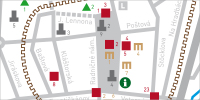 
  |
The Greek Catholic church of Saint Nicolas built in 1775 is considered to be among the most beautiful wooden churches of eastern tradition in the Carpathians. The church is now located in the Museum of Folk Architecture in Bardejovské Kúpele (Bardejov Spa), located 6 kilometers to the north of Bardejov. The church was relocated there in 1967 from the Slovak-Polish-Ukrainian border village of Zboj.
The village of Zboj and its church was in the thick of fighting during world war two and suffered heavy damage because of it. The church was repaired only to be subsequently replaced by a new bricked structure. The wooden church was then disassembled, moved to Bardejovské Kúpele and rebuilt there a new.
The church is a three part building with three towers and crosses. The entry is located on the western side of the church. The upper part of the main tower sports a conical rather than an onion shaped dome and a three-bar cross. The upper structure covering the nave and the sanctuary is of similar design.
|
The church has one of the most beautiful and best preserved eighteenth century iconostasis. The iconostasis is composed of four levels.Each level consists of four rows. The first row contains four major icons – that of Saint Bishop Nicolas, Mother of God Hodegetria, Christ the Teacher and the icon of the Three Hierarchs (Saint Basil the Great, Saint John Chrysostom, Saint Gregory of Nazianzus).
The royal doors are adorned by six medallions depicting four Evangelists and two scenes from the Annunciation.
The second row of icons depicts feast days. Right in the center amid the icons is the representation of the Last Supper. The third row contains icons depicting the apostles including an icon of Christ the High Priest. The fourth row comprises the icons of prophets and is divided into twelve medallions arranged into three semi-arches.
|
The top of the iconostasis is adorned by a seventeenth century depiction of the Calvary and the Crucifixion. The image of the Mother of God as well as the image of Saint John the Evangelist flank the Crucifixion scene in an atypical inverted fashion.
Most parts of the iconostasis are dated to the eighteenth century. A minority of the icons – including the icon of Saint Nicolas and the Crucifixion are earlier seventeenth century pieces.
At present the building is used by the members of the Orthodox Church.
Location:
maps.google.com
Source:
drevenechramy.sk
Translated by:
Mgr. Samuel Beňa, M.A.
Tips for Trips:
www.tik.bardejov.travel
|













